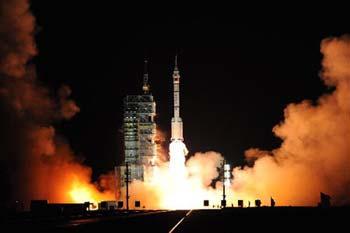China
China´s manned spacecraft Shenzhou-7 blasts off
Source: Xinhua | 09-26-2008 09:26
Special Report: Tech MaxSpecial Report: Shenzhou-7 Manned Space Flight
JIUQUAN, Gansu, Sept. 25 (Xinhua) -- China successfully launched its third manned spacecraft on Thursday with three astronauts on board to attempt the country's first-ever space walk.
 |
| The Long-March II-F carrier rocket carrying the Shenzhou- 7 spaceship blasts off from the launch pad at the Jiuquan Satellite Launch Center in northwest China's Gansu Province, on 21:10 p.m., Sept. 25, 2008. (Xinhua photo) |
The spaceship Shenzhou-7 blasted off on a Long March II-F carrier rocket from the Jiuquan Satellite Launch Center in the northwestern Gansu Province at 9:10 p.m. after a breathtaking countdown to another milestone on China's space journey.
Onboard pilots Zhai Zhigang, Liu Boming and Jing Haipeng are expected to orbit the earth for three days, when one of them will float out of the cabin about 343 kilometers above the earth.
When they make it, China will become the third country in the world who is able to conduct extravehicular activity (EVA) in space following the former Soviet Union and the United States.
President Hu Jintao watched the historic moment at the launch center, joined by senior Communist Party of China (CPC) official Zhou Yongkang, Chinese space scientists and other work staff.
Hu congratulated experts and taikonauts on the successful launch of Shenzhou-7, which was declared about 22 minutes after the liftoff by chief commander Gen. Chang Wanquan of the manned space project.
"The successful launch marked the first victory of the Shenzhou-7 mission," Hu said in a brief speech after Chang announced the spacecraft entered the preset orbit.
He hailed the mission as "another feat on the Chinese people's journey to ascend the peak of science and technology", urging the staff to carry on their efforts to achieve a full-scale triumph.
FLY IN SPACE
It was China's third consecutive successful launch of a manned spacecraft since the country sent its first man into space in 2003. Two taikonauts flew in 2005.
From a screen at the BACC showing real-time pictures of the astronauts, the pilots, all 42 years old, looked calm during the launch, waving their hands to the camera from time to time. Zhai was seen flipping through the operation manual and making a gesture of victory with two fingers up.
Two of the trio would enter the orbital module, where one would put on domestically-made spacesuit Feitian and leave the module to take back test samples loaded outside, said Zhou Jianping, chief designer of the country's manned space project.
The other would wear a Russian Orlan suit and stay in the depressurized cabin for support, said Zhou.
"We wish we could fly freely in space just like Feitian on the ancient Buddhist murals, so we gave this name to the homemade spacesuit," said Zhou.
Feitian, which literally means flying in the sky, is the name of a legendary Buddhist goddess.
Other tasks of the Shenzhou-7 crew include the release of a small monitoring satellite and a trial of the data relay of the satellite Tianlian-I.
If successful, the mission would be of great significance to the country's future plans to build a space lab and a space station, said Zhang Jianqi, deputy chief commander of the manned space project.
"China pursues the principle of making peaceful use of space in its exploration and development," Zhang told Xinhua, saying the country was willing to carry out various forms of international cooperation in space exploration.
The country has announced that its manned space program is being carried out in three stages, which eventually lead to the establishment of a permanent space station.
The planned space walk during the Shenzhou-7 mission will be one key step of the program's second stage, which also involves the docking between capsule and space module and establishment of a space lab.
China has made a series of technical breakthroughs for the Shenzhou-7 project, including the independent research and development of the world's most expensive EVA suit, which costs 30million yuan (about 4.4 million U.S. dollars) each, scientists said.
Among other highlights were a new airlock module that didn't appear in the previous six flights and a safer, more comfortable rocket with 36 technological improvements.
The spaceship is scheduled to land in the central region of north China's Inner Mongolia Autonomous Region after completing the task.



